Analysis of the Effect of a Vertical Magnetic Field on Melt Convection and Oxygen Transport During Directional Solidification of Multi-Crystalline Silicon by Numerical Simulation
Abstract
1. Introduction
2. Model Description and Calculation Method
2.1. Directional Solidification System
2.2. Calculation Method
3. Control of Magnetic Field
4. Results and Discussion
5. Conclusions
- (1)
- As the magnetic field intensity increases, the convection in the melt is more affected by the Lorentz force, and the melt convection velocity decreases significantly with the increase of the magnetic flux density. However, in the later stage of crystallization, the melt velocity is small enough that the effect of the Lorentz force on the convection is no longer significant.
- (2)
- When the magnetic field intensity is small, the size of the oxygen retention region in the melt is larger, but the average oxygen concentration in the oxygen retention region is smaller. Increasing the magnetic field intensity, the size of the oxygen retention region in the melt becomes smaller, but the average oxygen concentration in the oxygen retention region is larger. However, increasing the intensity of the magnetic field is beneficial for reducing the total oxygen content in the silicon melt.
Author Contributions
Funding
Conflicts of Interest
References
- Li, J.D.; Chen, Y.F.; Hong, R.J. Modeling and optimization of the feedstock melting for industrial photovoltaic multi-crystalline silicon ingot. Sol. Energy 2016, 139, 108–115. [Google Scholar] [CrossRef]
- Gao, B.; Nakano, S.; Kakimoto, K. Reducing impurities of multicrystalline silicon in a unidirectional solidification furnace for solar cells. JOM 2011, 63, 43–46. [Google Scholar] [CrossRef]
- Ide, T.; Harada, H.; Miyamura, Y.; Imai, M.; Nakano, S.; Kakimoto, K. Relationship between dislocation density and oxygen concentration in silicon crystals during directional solidification. Crystals 2018, 8, 244. [Google Scholar] [CrossRef]
- Gao, B.; Chen, X.J.; Nakano, S.; Kakimoto, K. Crystal growth of high-purity multicrystalline silicon using a unidirectional solidification furnace for solar cells. J. Cryst. Growth 2010, 312, 1572–1576. [Google Scholar] [CrossRef]
- Teng, Y.Y.; Chen, J.C.; Huang, B.S.; Chang, C.H. Numerical simulation of impurity transport under the effect of a gas flow guidance device during the growth of multicrystalline silicon ingots by the directional solidification process. J. Cryst. Growth 2014, 385, 1–8. [Google Scholar] [CrossRef]
- Teng, Y.Y.; Chen, J.C.; Lu, C.W.; Chen, H.I.; Hsu, C.; Chen, C.Y. Effects of the furnace pressure on oxygen and silicon oxide distributions during the growth of multicrystalline silicon ingots by the directional solidification process. J. Cryst. Growth 2011, 318, 224–229. [Google Scholar] [CrossRef]
- Nakano, S.; Gao, B.; Kakimoto, K. Relationship between oxygen impurity distribution in multicrystalline solar cell silicon and the use of top and side heaters during manufacture. J. Cryst. Growth 2013, 375, 62–66. [Google Scholar] [CrossRef]
- Kesavan, V.; Srinivasan, M.; Ramasamy, P. Optimizing oxygen impurities using different heater design in the directional solidification of multi-crystalline silicon. Mater. Res. Express 2019, 6, 106323. [Google Scholar] [CrossRef]
- Liu, L.J.; Ma, W.C.; Qi, X.F.; Li, Z.Y.; Zhang, Y.F. Global simulation of coupled oxygen and carbon transport in an industrial directional solidification furnace for crystalline silicon ingots: Effect of crucible cover coating. Int. J. Heat. Mass. Tran. 2017, 108, 2355–2364. [Google Scholar] [CrossRef]
- Trempa, M.; Reimann, C.; Friedrich, J.; Muller, G. The influence of growth rate on the formation and avoidance of c and n related precipitates during directional solidification of multi crystalline silicon. J. Cryst. Growth 2010, 312, 1517–1524. [Google Scholar] [CrossRef]
- Dadzis, K.; Vizman, D.; Friedrich, J. Unsteady coupled 3d calculations of melt flow, interface shape, and species transport for directional solidification of silicon in a traveling magnetic field. J. Cryst. Growth 2013, 367, 77–87. [Google Scholar] [CrossRef]
- Su, W.J.; Li, C.; Qi, X.F.; Yang, W.; Wang, J.F. Numerical analysis and optimization of gas flow and impurity control in directional solidification multi-crystalline si. J. Cryst. Growth 2019, 527, 125244. [Google Scholar] [CrossRef]
- Li, Z.Y.; Liu, L.J.; Liu, X.; Zhang, Y.F.; Xiong, J.F. Heat transfer in an industrial directional solidification furnace with multi-heaters for silicon ingots. J. Cryst. Growth 2014, 385, 9–15. [Google Scholar] [CrossRef]
- Chen, W.L.; Wu, Z.Y.; Zhong, G.X.; Ding, J.J.; Yu, Y.Y.; Zhou, X.C.; Huang, X.M. Optimization of heat transfer by adjusting power ratios between top and side heaters for casting high-performance multi-crystalline silicon ingots. J. Cryst. Growth 2016, 451, 155–160. [Google Scholar] [CrossRef]
- Cablea, M.; Zaidat, K.; Gagnoud, A.; Nouri, A.; Delannoy, Y. Directional solidification of silicon under the influence of travelling magnetic field. J. Cryst. Growth 2014, 401, 883–887. [Google Scholar] [CrossRef]
- Li, Z.Y.; Qi, X.F.; Liu, L.J.; Zhou, G.S. Numerical study of melt flow under the influence of heater-generating magnetic field during directional solidification of silicon ingots. J. Cryst. Growth 2018, 484, 78–85. [Google Scholar] [CrossRef]
- Yu, Q.H.; Liu, L.J.; Li, Z.Y.; Su, P. Global simulations of heat transfer in directional solidification of multi-crystalline silicon ingots under a traveling magnetic field. J. Cryst. Growth 2014, 401, 285–290. [Google Scholar] [CrossRef]
- Popescu, A.; Vizman, D. Numerical study of the influence of forced melt convection on the impurities transport in a silicon directional solidification process. J. Cryst. Growth 2017, 474, 55–60. [Google Scholar] [CrossRef]
- Moller, H.J.; Long, L.; Werner, M.; Yang, D. Oxygen and carbon precipitation in multicrystalline solar silicon. Phys. Status. Solidi. A 1999, 171, 175–189. [Google Scholar] [CrossRef]
- Moller, H.J.; Funke, C.; Lawerenz, A.; Riedel, S.; Werner, M. Oxygen and lattice distortions in multicrystalline silicon. Sol. Energy Mater. Sol. Cells 2002, 72, 403–416. [Google Scholar] [CrossRef]
- Gao, B.; Nakano, S.; Kakimoto, K. Reduction of oxygen impurity in multicrystalline silicon production. Int. J. Photoenergy 2013. [Google Scholar] [CrossRef]
- Yu, Q.H.; Liu, L.J.; Li, Z.Y.; Shao, Y. Parameter study of traveling magnetic field for control of melt convection in directional solidification of crystalline silicon ingots. Int. J. Heat Fluid Flow 2018, 71, 55–67. [Google Scholar] [CrossRef]
- Vizman, D.; Tanasie, C. Novel method for melt flow control in unidirectional solidification of multi-crystalline silicon. J. Cryst. Growth 2013, 372, 1–8. [Google Scholar] [CrossRef]
- Tanasie, C.; Vizman, D.; Friedrich, J. Numerical study of the influence of different types of magnetic fields on the interface shape in directional solidification of multi-crystalline silicon ingots. J. Cryst. Growth 2011, 318, 293–297. [Google Scholar] [CrossRef]
- Fang, H.S.; Wang, S.; Zhou, L.; Zhou, N.G.; Lin, M.H. Influence of furnace design on the thermal stress during directional solidification of multicrystalline silicon. J. Cryst. Growth 2012, 346, 5–11. [Google Scholar] [CrossRef]
- Chen, X.J.; Nakano, S.; Kakimoto, K. Three-dimensional global analysis of thermal stress and dislocations in a silicon ingot during a unidirectional solidification process with a square crucible. J. Cryst. Growth 2010, 312, 3261–3266. [Google Scholar] [CrossRef]
- Yang, X.; Ma, W.H.; Lv, G.Q.; Wei, K.X.; Luo, T.; Chen, D.T. A modified vacuum directional solidification system of multicrystalline silicon based on optimizing for heat transfer. J. Cryst. Growth 2014, 400, 7–14. [Google Scholar] [CrossRef]
- Chen, J.C.; Chiang, P.Y.; Nguyen, T.H.T.; Hu, C.; Chen, C.H.; Liu, C.C. Numerical simulation of the oxygen concentration distribution in silicon melt for different crystal lengths during czochralski growth with a transverse magnetic field. J. Cryst. Growth 2016, 452, 6–11. [Google Scholar] [CrossRef]
- Ding, C.L.; Huang, M.L.; Zhong, G.X.; Ming, L.; Huang, X.M. A design of crucible susceptor for the seeds preservation during a seeded directional solidification process. J. Cryst. Growth 2014, 387, 73–80. [Google Scholar] [CrossRef]
- Ganesan, N.S.; Manickam, S.; Karuppanan, A.; Perumalsamy, R. Simulation analysis on impurity distribution in mc-si grown by directional solidification for solar cell applications. Int. J. Mater. Res. 2016, 107, 525–533. [Google Scholar] [CrossRef]
- Matsuo, H.; Ganesh, R.B.; Nakano, S.; Liu, L.J.; Kangawa, Y.; Arafune, K.; Ohshita, Y.; Yamaguchi, M.; Kakimoto, K. Thermodynamical analysis of oxygen incorporation from a quartz crucible during solidification of multicrystalline silicon for solar cell. J. Cryst. Growth 2008, 310, 4666–4671. [Google Scholar] [CrossRef]
- Togawa, S.; Huang, X.M.; Izunome, K.; Terashima, K.; Kimura, S. Oxygen-transport analysis in czochralski silicon melt by considering the oxygen evaporation from the melt surface. J. Cryst. Growth 1995, 148, 70–78. [Google Scholar] [CrossRef]
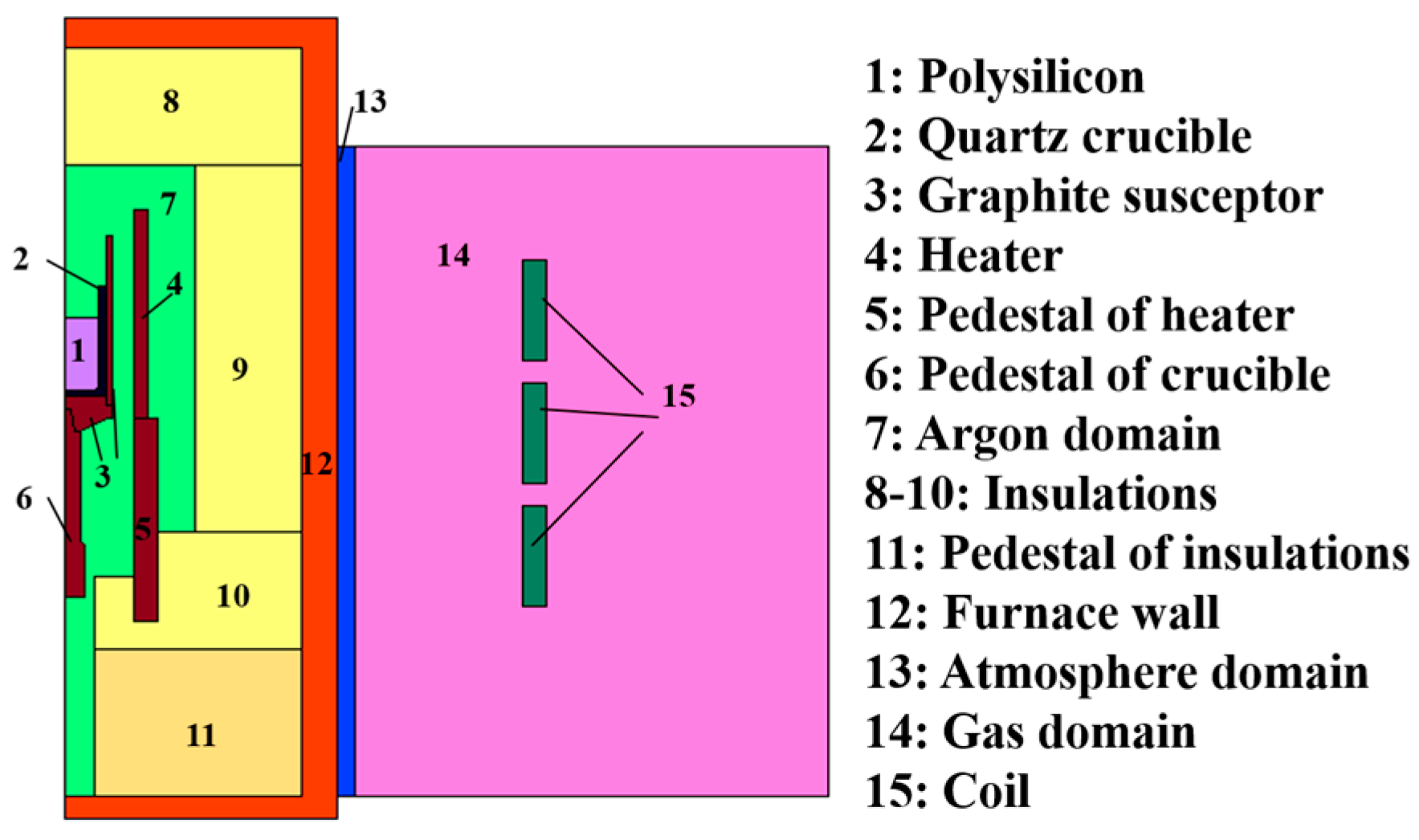
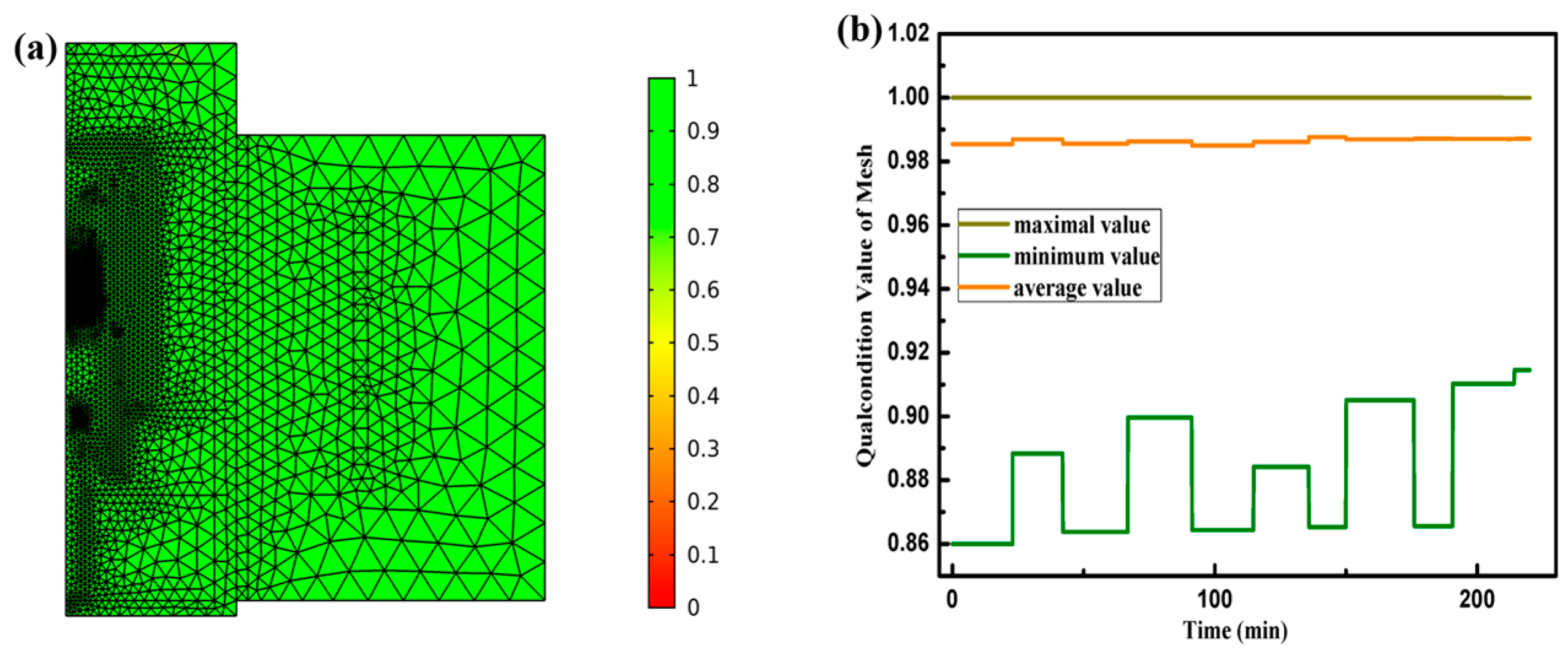
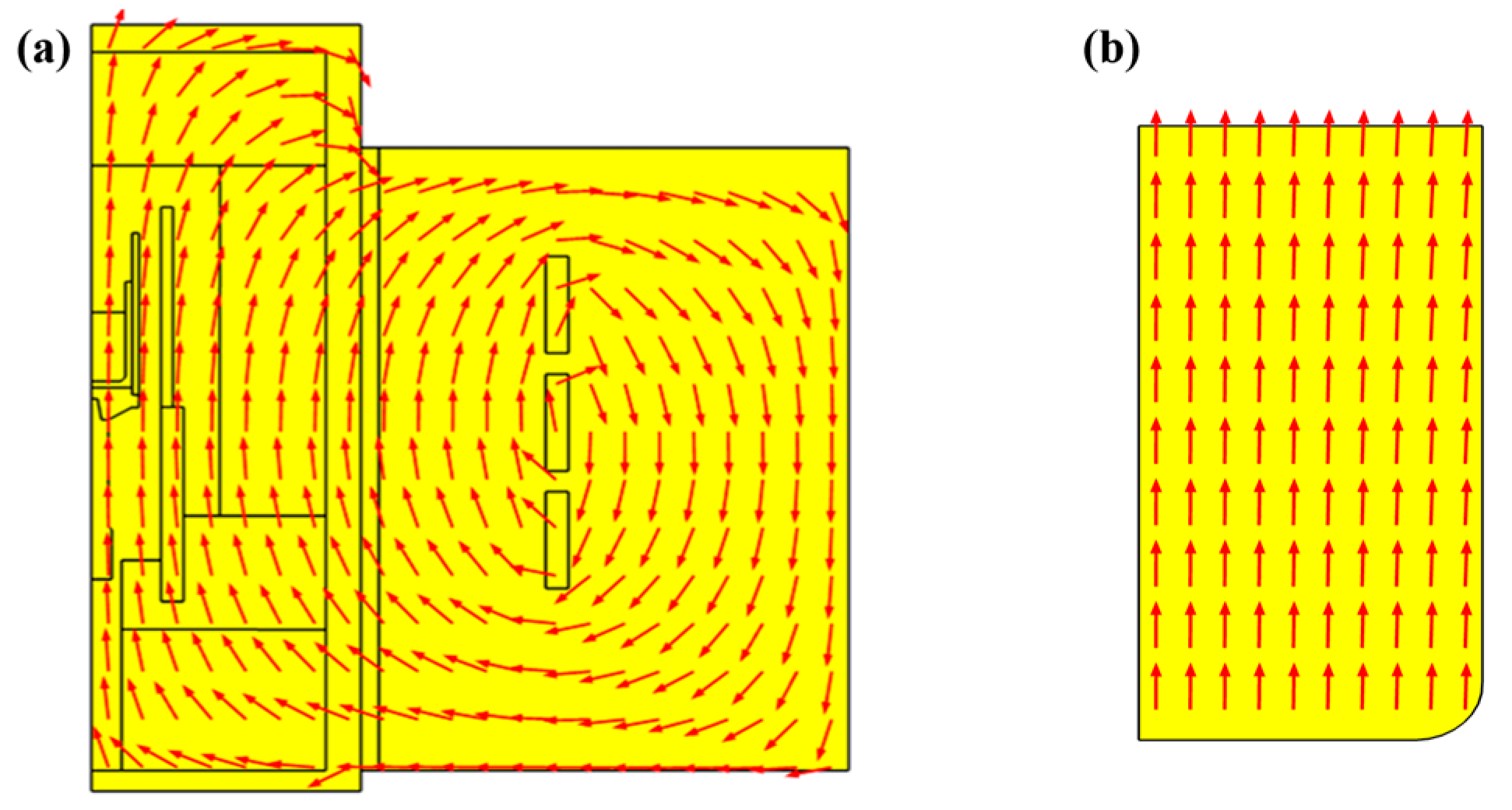
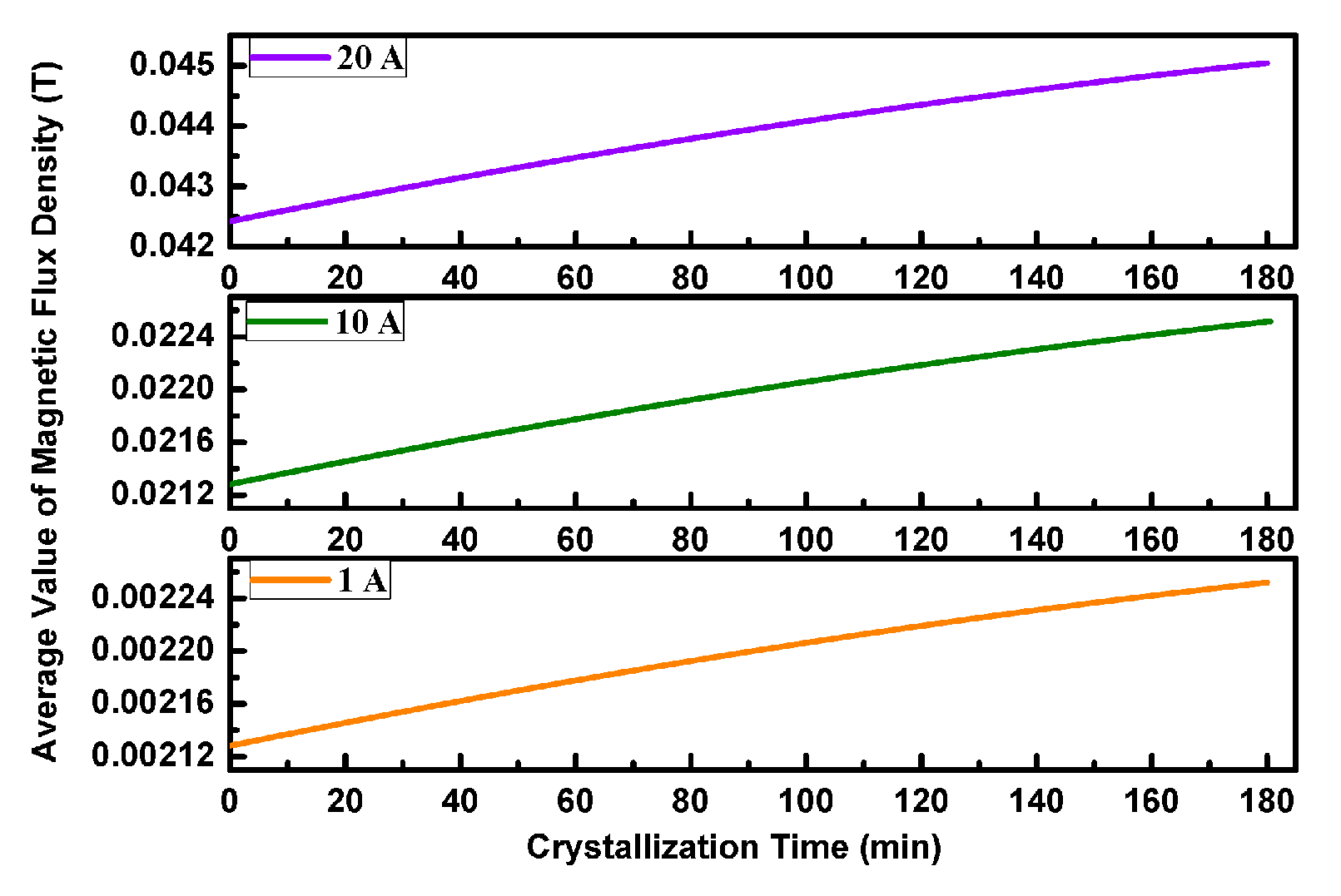
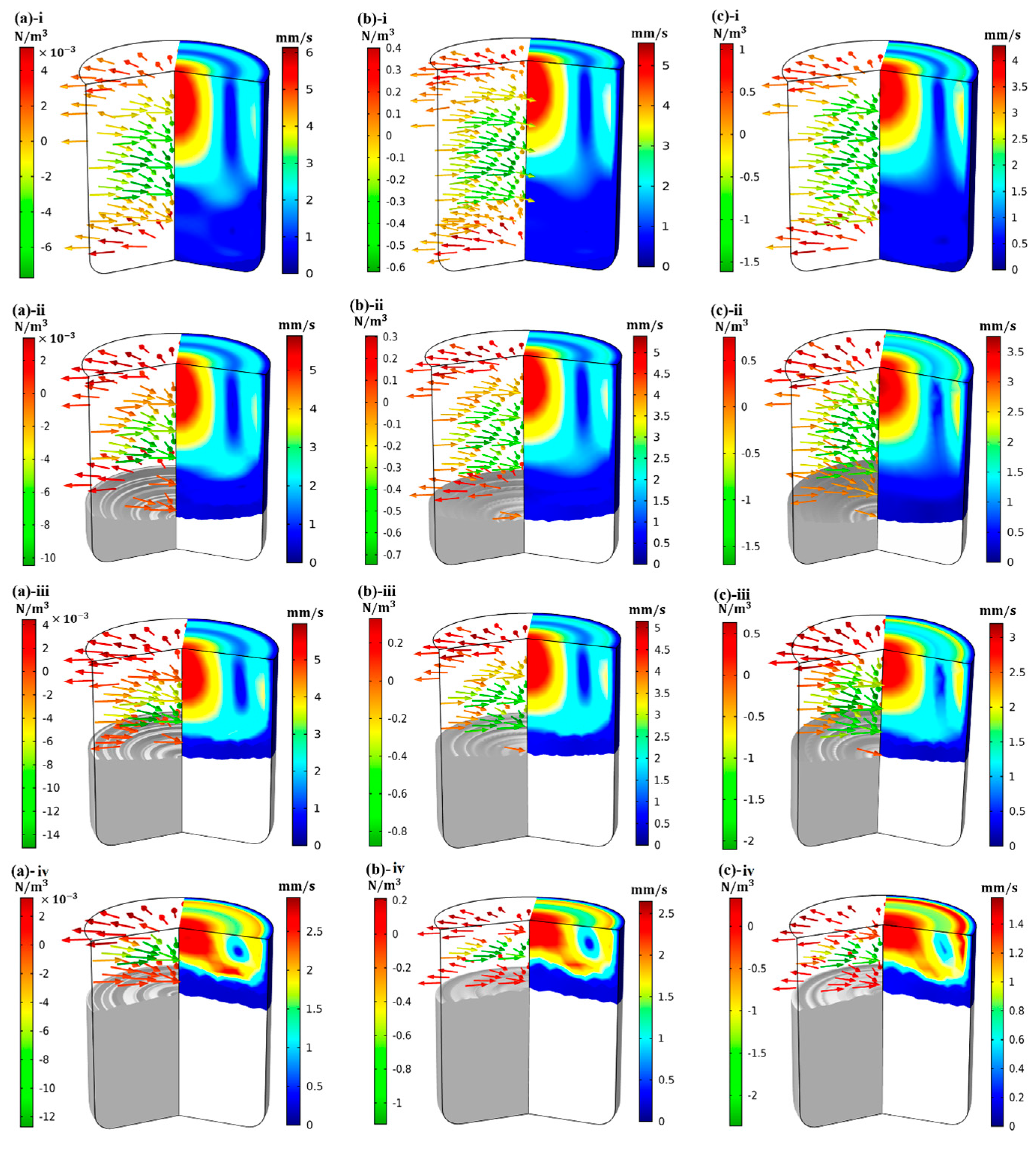
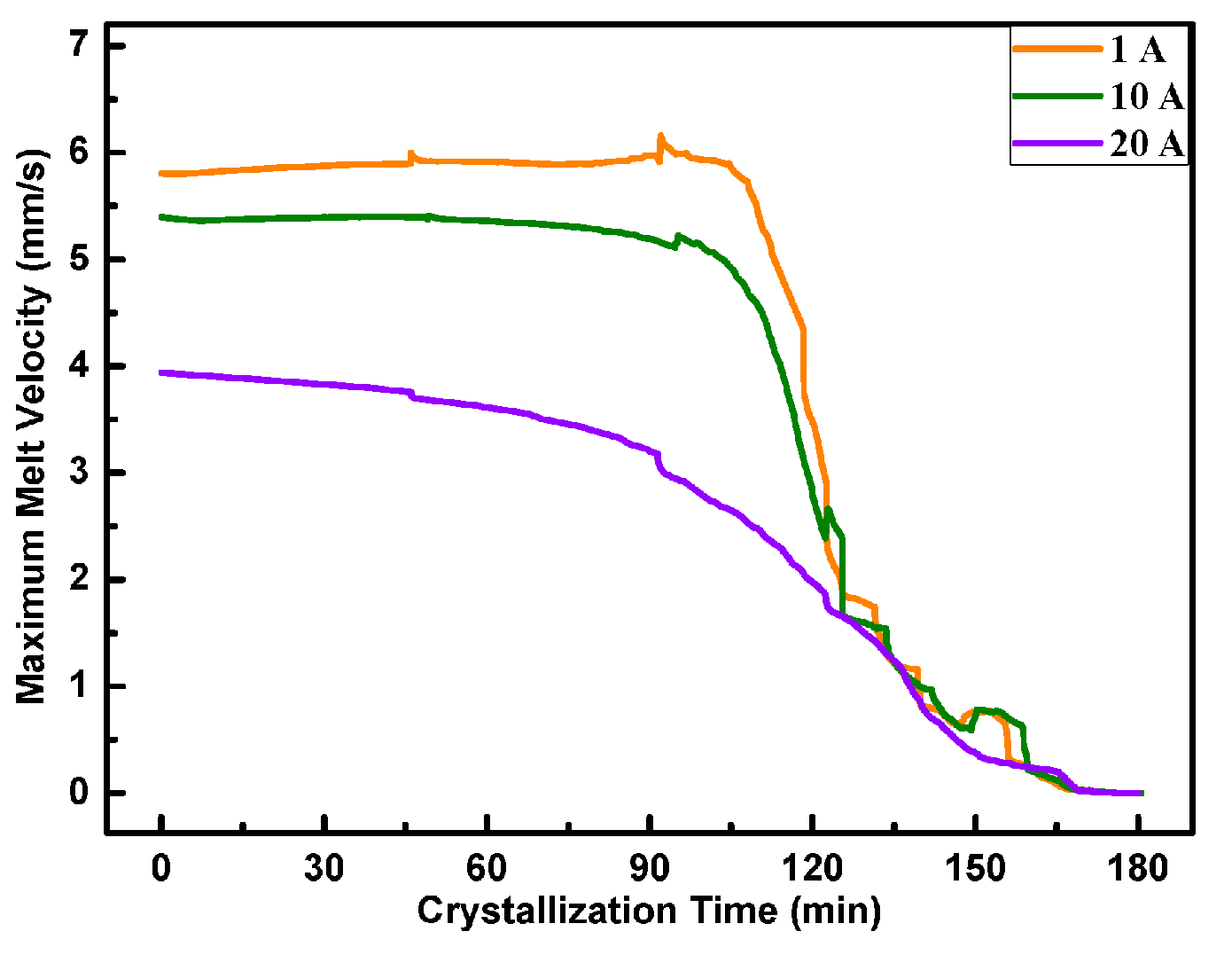
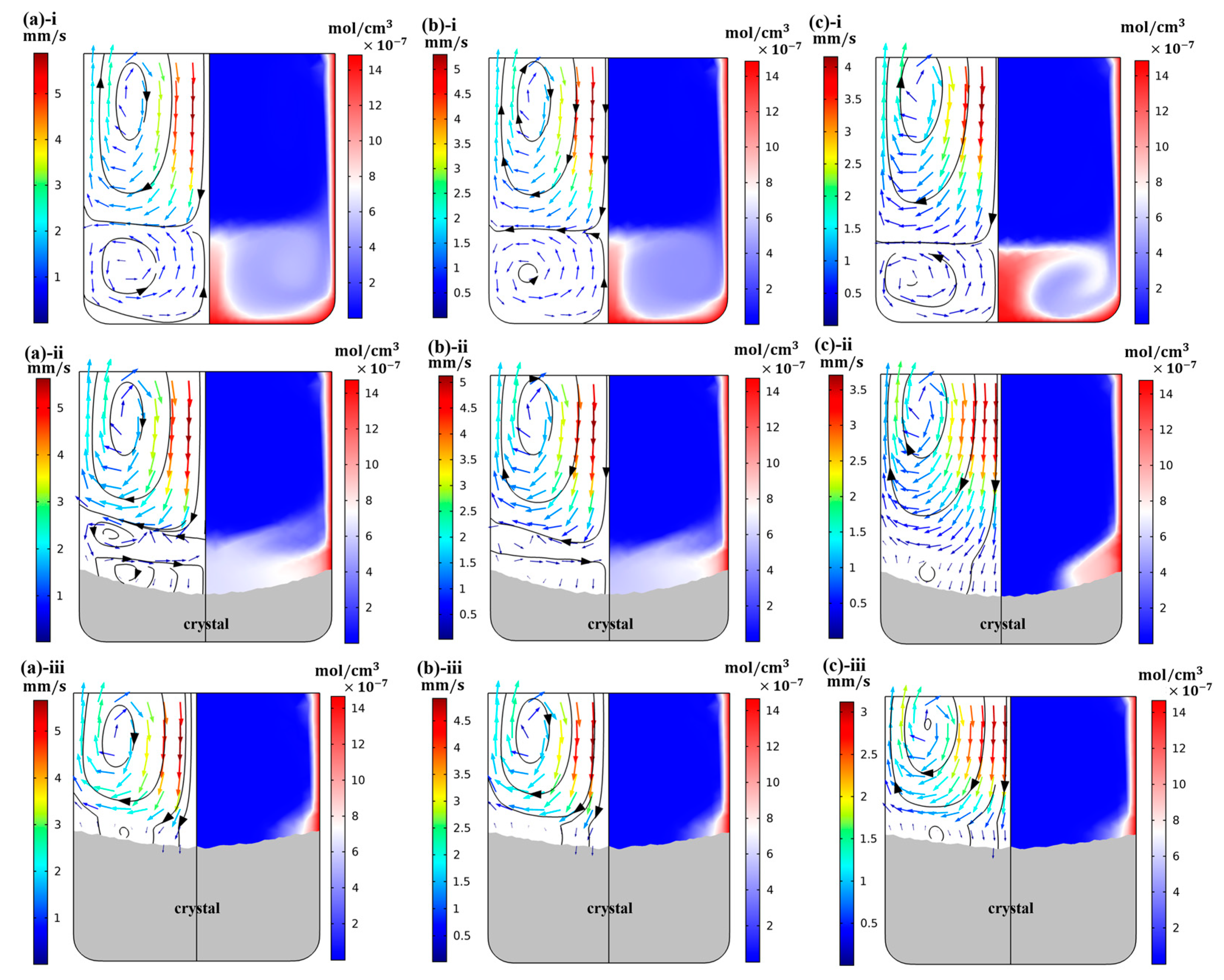
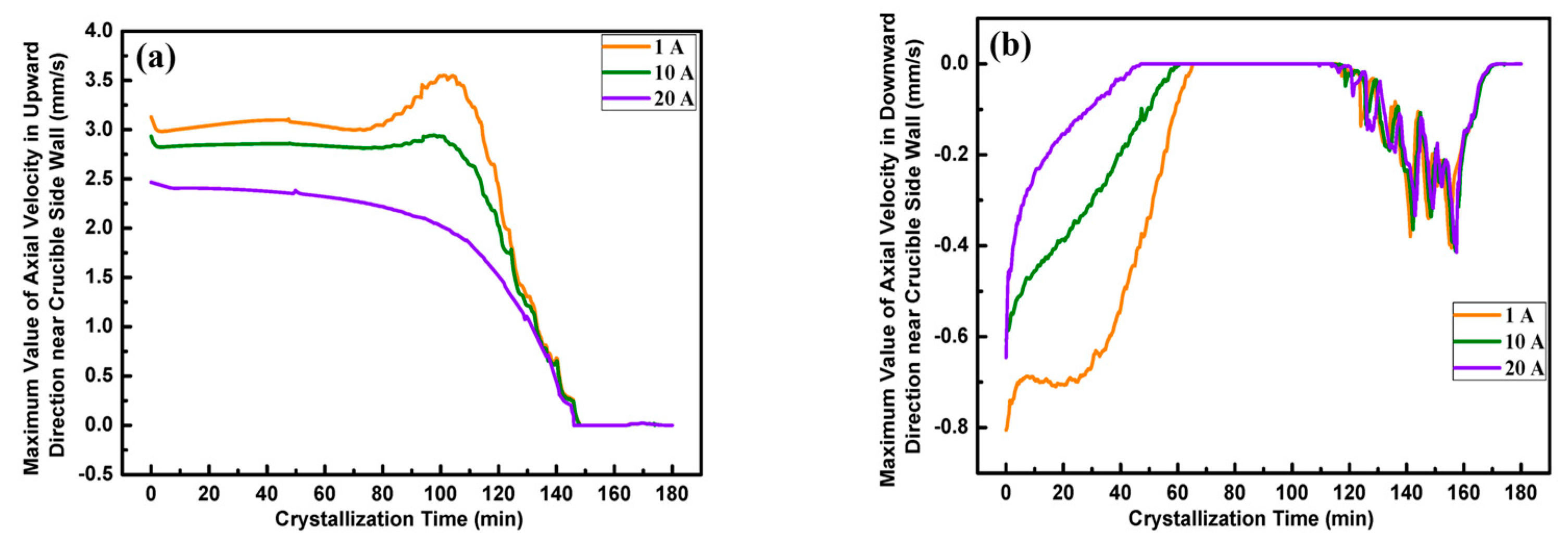

© 2019 by the authors. Licensee MDPI, Basel, Switzerland. This article is an open access article distributed under the terms and conditions of the Creative Commons Attribution (CC BY) license (http://creativecommons.org/licenses/by/4.0/).
Share and Cite
Song, B.; Luo, Y.; Rao, S.; Zhang, F.; Hu, Y. Analysis of the Effect of a Vertical Magnetic Field on Melt Convection and Oxygen Transport During Directional Solidification of Multi-Crystalline Silicon by Numerical Simulation. Crystals 2020, 10, 8. https://doi.org/10.3390/cryst10010008
Song B, Luo Y, Rao S, Zhang F, Hu Y. Analysis of the Effect of a Vertical Magnetic Field on Melt Convection and Oxygen Transport During Directional Solidification of Multi-Crystalline Silicon by Numerical Simulation. Crystals. 2020; 10(1):8. https://doi.org/10.3390/cryst10010008
Chicago/Turabian StyleSong, Botao, Yufeng Luo, Senlin Rao, Fayun Zhang, and Yun Hu. 2020. "Analysis of the Effect of a Vertical Magnetic Field on Melt Convection and Oxygen Transport During Directional Solidification of Multi-Crystalline Silicon by Numerical Simulation" Crystals 10, no. 1: 8. https://doi.org/10.3390/cryst10010008
APA StyleSong, B., Luo, Y., Rao, S., Zhang, F., & Hu, Y. (2020). Analysis of the Effect of a Vertical Magnetic Field on Melt Convection and Oxygen Transport During Directional Solidification of Multi-Crystalline Silicon by Numerical Simulation. Crystals, 10(1), 8. https://doi.org/10.3390/cryst10010008




